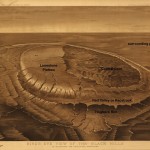by Adrienne Mayor (Wonders & Marvels contributor)
The Black Hills of South Dakota, sacred to the Lakota Sioux, are surrounded by the fossil deposits of masses of extinct creatures, from Cretaceous dinosaurs and marine reptiles that died out 65 million years ago to mammoths of the Pleistocene (1.7 to 10,000 years ago). The remarkable fossilized bones that continually weather out of the soil on the prairies around the Black Hills were observed by Native Americans over countless generations. Many oral traditions account for the strange remains of enormous creatures no longer seen alive.
The Black Hills are also surrounded by a curious geological depression. The mountains are encircled by a broad valley of red siltstone that has eroded through the greenish Morrison Formation sediments just inside a steep ring of Cretaceous hogback ridges. This race-course-like landform rimmed with abundant fossil bone beds was noticed by the Lakota. The myth of the “Big Race,” recounted by Lakota storyteller James LaPointe in 1976, explains the conspicuous geological feature and the layers of immense bones.
The myth begins in the “first sunrise of time,” before the existence of the Black Hills. The Earth summoned all the creatures to a great race to bring order into the violent, chaotic world. The land was covered with a seething crowd of animals. Their fate was at hand! They began to run in a great circle. The earth trembled under the impact of the running beasts and the sky darkened with circling birds. Around and around the racing animals sped. Many fell behind and the weaker ones were trampled, amid the din of groans, cries, roars, and screams. As they ran the earth beneath them began to sink crazily under their weight and a huge mound began to bulge in the center. The rising mountain burst and spewed fire and rock, which mixed with the clouds of dust thrown up by the desperate racers. The animals were struck down by flying rocks and smothered in ashes and debris; but some birds survived. Now, say the Lakotas, the remains of the great racecourse are still visible in the blood-red valley around the Black Hills and the bones of the long-ago beasts lie buried where they fell.
With surprising insight, the tale told by LaPointe suggests a concept of extinction as a pitiless race for survival and pictures a catastrophic event in deep time to explain the geological and paleontological evidence. In fact, during the Cretaceous and Miocene (145 million to 5 million years ago), intense volcanic and tectonic forces violently uplifted a 7,500 foot dome of granite rock. Erosion ate away the ash and soil atop and around the dome, creating the race-course-like valley around the Black Hills.
About the author: Adrienne Mayor is a Research Scholar in Classics and History of Science, Stanford University. This is an excerpt from chapter 5 of Mayor’s “Fossil Legends of the First Americans” (2005), citing James LaPointe’s Legends of the Lakota (1976); “The First Fossil Hunters: Dinosaurs, Mammoths, and Myths in Greek and Roman Times” (2011), and “The Poison King: The Life and Legend of Mithradates, Rome’s Deadliest Enemy,” a nonfiction finalist for the 2009 National Book Award.
